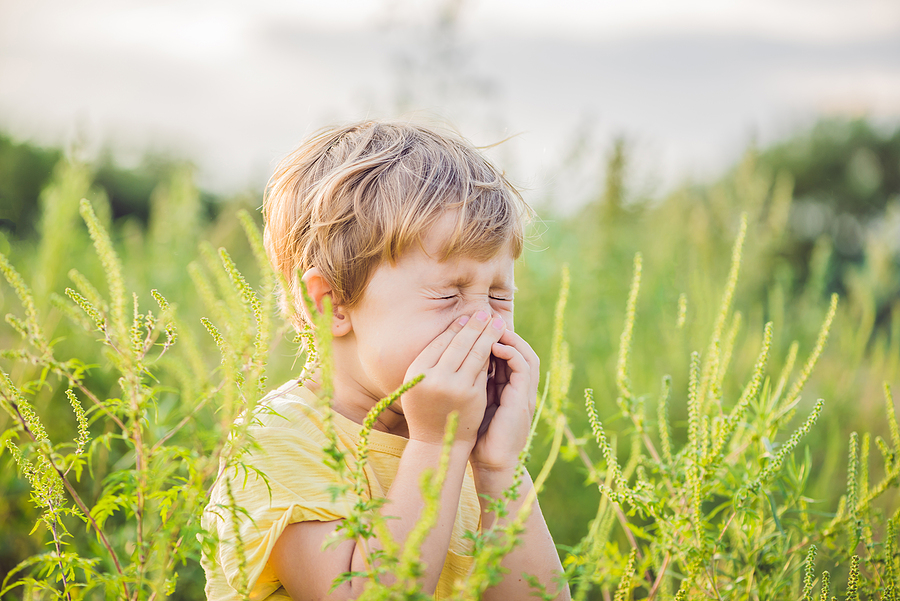
A nagging tickle in your throat has you coughing nonstop for hours and keeps you up all night. No matter how much you cough, you can’t seem to clear your throat. You’ve coughed so much your throat stings. Coughs may … Continue reading
READ MORE
Fresno’s lush fields, orchards, and forest areas provide visitors and residents with an abundance of outdoor activity options. Yet, there’s a downside to the trees, flowers, and grasses. Ragweed loves the warm temperatures and dry air.
Ragweed is the cause of high allergy rates, especially from August through October. As pollen reaches peak counts in September and October, your allergy symptoms flare up. You’re miserable and don’t know what to do to ease the itching, sneezing, watery eyes, and runny nose.
You’re visiting Fresno for peak grape harvesting season at the area vineyard. Maybe you live in the area and are outside to go to work, watch your child’s games and practices, or love hiking on the multitude of trails. You need practical solutions to help you navigate seasonal ragweed allergies.
What exactly is ragweed? It’s a member of the aster family that’s found across the U.S. It’s fast-spreading and contains fern-like leaves with spiky flowers at the end of each stem. It’s those seed-like flowers that spread a lot of lightweight, microscopic pollen on windy, dry late-summer and fall days.
There are approximately 50 types of ragweed. Common, giant, and western are the most prevalent in Fresno. Common ragweed grows as high as 6 feet, while giant ragweed gets as high as 17 feet. Western ragweed is the shortest, averaging 3 feet tall.
One ragweed plant produces many millions of pollen grains. As one plant is estimated to contain close to 1 billion pollen grains, it’s not surprising that ragweed is the most common pollen-triggered allergy.
Ragweed itself looks terrifying under a microscope. The small, round pollen particles are covered in sharp spikes. When they enter your airways, they irritate the lining of the nasal passages, triggering your immune system’s response.
Your immune system sees ragweed pollen as an invader. It triggers histamine release to fight the invader, and that histamine response leads to the inflammation that causes watery eyes, a runny nose, and itching.
One reason ragweed is so problematic is that its pollen is light and can travel long distances with the wind. It stays airborne for up to 100 miles due to its lightweight nature, making it easy to breathe in when you’re outside.
The pollen travels a long way, and it’s one of the toughest pollens. Even after falling to the ground in the rain, it breaks pollen clusters up into smaller ones, and they go back into the air when it’s dry again.
Another issue is that ragweed is tough to kill. Most species grow from rhizomes underground. They branch off into many underground roots that extend deep into the ground.
With western ragweed, the root system can go as far as 6 feet underground. You must get every single one when weeding or the weed can return. Removing the plant is not effective in controlling it, plus pollen from one plant can travel dozens of miles. The pollen you’re breathing could be from a plant that’s miles away.
Ongoing studies believe that global warming’s warmer temperatures and increasing carbon dioxide levels pose a new issue. Ragweed’s growing time is lengthening, which makes it possible for a seasonal ragweed allergy to last longer than before.
Allergy remedies that worked for you in the past may no longer be as effective. It’s time to adapt your allergy plan. You need to create a comprehensive approach to managing ragweed allergies.
When ragweed pollen travels as far as 100 miles, how do you ease your allergies? A three-area approach is your best bet.
1. Indoor Environment
Start your allergy-prevention measures with a few changes in your home. Start with your vacuum. If you don’t have a vacuum with a built-in HEPA filter, invest in one. You want a vacuum that actively removes pollen from your carpets and upholstery, rather than just pushing or blowing it back around the room.
If you have an HVAC system and ducts, make sure you’re using a filter with the highest allowed MERV rating. You want a filter to capture as much dust and pollen as possible without straining your cooling or heating system.
If you have a boiler or radiant floor heating system, an air purifier is essential. You want a system that captures as many particles as possible and runs continuously, day and night. Eco-friendly systems keep the air clean without driving your heating bills up too high.
Consider having air purifiers in the rooms you spend the most time in. Your bedroom, main living area, and home office are all areas where an air purifier can make a big difference.
2. Outdoor Environment
When you’re outside, limit your time to hours when ragweed pollen counts are low. Aim for early morning to noon. Stay inside when it’s low humidity and windy, as that’s when pollen counts peak.
While rain is more likely in the fall and winter months, any rainy days in September and October will temporarily knock down pollen counts. Grab an umbrella or a rain jacket and go outside for a walk.
Before you go into your home, strip off your outer layers of clothing and your jacket. Put them straight into the washing machine. Leave your shoes outside in the garage, on a front porch, or on a patio. It keeps pollen outside. Once that’s done, head to the shower and rinse pollen out of your hair and off your skin.
If you have flower beds or garden areas, watch for ragweed and pull as much of it as you can. Use gloves and wear a mask if you have severe ragweed allergies. It will return, so be proactive in pulling the weed when you see it.
3. Allergy Medicines
Allergy medicines help ease symptoms. Use them to keep your ragweed allergy from making you miserable. Over-the-counter antihistamines help reduce histamine levels, helping prevent symptoms from flaring.
Saline nasal sprays or neti pots help flush allergens from your nasal cavity. They can be just as effective if you don’t want to use medications that make you drowsy.
An allergist is a must when you have ragweed allergies. When you see an allergist, you get tested to identify your allergens, and prescription allergy medications are an option if nothing else helps.
You can also work with an allergist to get lasting relief. Allergy shots help your immune system build a tolerance and stop a severe reaction when you’re exposed to ragweed pollen. There are two forms of allergy shots.
If you hate needles, sublingual (SLIT) immunotherapy is a non-invasive option involving oral drops or dissolvable tablets that go under the tongue. Like SCIT allergy shots, they’re taken daily for 3 to 5 years.
Premium Allergy & Respiratory Center’s allergy doctor is your partner in ending ragweed allergies. Make an appointment today and get the relief from ragweed allergies that helps you enjoy Fresno’s weather and natural attractions.